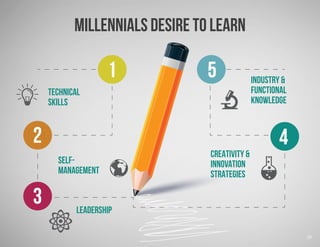This document provides an overview of managing millennials in the workforce. It begins with defining millennials as those born between 1980-2000 and how they differ from previous generations due to growing up with technology. It then compares millennials to other generations and provides a timeline of generational experiences. The document outlines what makes millennials unique, such as their education, tech-savviness, and expectations. It discusses effective ways to motivate, manage, and train millennials, including clear standards, frequent feedback, and investing in their development. The document also notes some costs associated with millennials, but ultimately argues they are worth the investment.









































